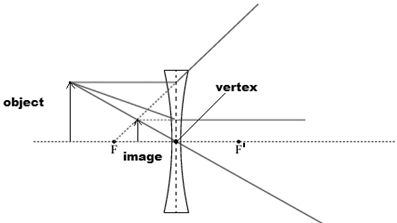Optics
Converging Lenses
- Converging lenses are always thicker in the middle than the top and bottom
- Light converges at the focal point when rays are parallel to the principal axis
- As long as rays are parallel they will converge somewhere on the focal plane
- There are principal focuses on both sides of the lens, but F prime (F’) is on the same side of the object
Like a mirror, there are three important rays when finding your image:
- Comes from object parallel to the principal axis and refracts through F.
- Comes from object straight through the vertex.
- Comes from the object, through F’ and is refracted parallel to the principal axis.
When the object is placed: Beyond 2F’
The image is: Between F and 2F, real, inverted smaller than the object.
When the object is placed: At 2F’
The image is: At 2F, real, inverted, the same size as the object.
When the object is placed: Between F’ and 2F’
The image is: Beyond 2F, real, inverted, larger than the object.
When the object is placed: At F’
The image is: No image is formed.
When the object is placed: Between lens and F’
The image is: Behind the object, virtual, erect, larger than the object.
Diverging Lenses
- Diverging lenses are always thinner in the middle and thicker on the top and bottom
- By extending rays, you can find the focal point
- F goes on the same side as the object
- The focal length and di will always be negative (image is always virtual, on the same side as object)
There are three important rays to find your image with a diverging lens:
- Comes in parallel from object and is reflected through F.
- Comes from object towards F’ and is reflected parallel.
- Comes from the object and through the vertex.
Pupil - regulates how much light can enter the eye
Cornea - protective layer
Optic nerve - sends a signal to the brain of what you’re seeing
Lens - focuses the light
Retina - captures the image
Ciliary muscles - alters focal length of the lens by pressure
Iris - changes shape to govern how much light can enter through the pupil
Aqueous humour - fluid that keeps the eye moist
Vitreous humour - fluid that helps the eye to keep its shape
Nearsightedness- also called myopia, occurs because the image is focused in front of the retina
Farsightedness- also called hypermetropia, occurs because the image is focused behind the retina
Applications of Lenses
There are many applications of lenses, two of which are:
Magnifying glass
- An object placed within the focal length of a converging lens will be bigger and right side up, so the image is magnified
Telescope
- Light enters the larger objective lens and creates a smaller image, even smaller than the object
- The eyepiece lens is placed so the image created by the objective lens is inside its focal length
- The image created by the objective lens acts as an object to the eyepiece lens; this second and final image is seen bigger and inverted
Colour
- Everything that can be seen is either reflecting or emitting light
- “White” light is made up of all the colours in the spectrum
- Coloured objects reflect some light and absorb others.
- Ex. a red apple reflects red light and absorbs green and blue
- Black objects absorb all light
The primary colours are:
- Red
- Blue
- Green
The secondary colours are:
- Magenta (blue + red)
- Cyan (blue + green)
- Yellow (green + red)
Example Question
Q: An American flag is illuminated by blue light. What colours will the blue, red, and white parts be? What if the red parts where magenta instead? Explain.
A: The blue and white parts will appear blue because they both reflect blue light. The white light is made up of all the colours, but because the light is blue it will only reflect blue. The red parts will appear black, because red as a colour contains no blue light, so can reflect none. If the red parts of the flag were magenta coloured instead, they would appear blue as well. Magenta reflects both blue and red light, but because the light is blue only the blue light would be seen while the red would be absorbed.
Polarization of Light
- Polarization of light means to block out some of the light
- As light travels, if you introduce a filter, some of it will be blocked out
- Some types of glasses have polarizing lenses and allow vertical light through, such as polarizing sunglasses or ski goggles
- When light reflects off of a flat surface, like snow or water, the light will be polarized horizontally
- To block out this horizontal light (glare off the water or snow), your filter must be polarized vertically (like glasses with vertical slits)
 Electromagnetic Spectrum
Electromagnetic SpectrumThe electromagnetic (EM) spectrum is the range of all types of EM radiation. Radiation is energy that travels and spreads out as it goes – the visible light that comes from a lamp in your house and the radio waves that come from a radio station are two types of electromagnetic radiation. The other types of EM radiation that make up the electromagnetic spectrum are microwaves, infrared light, ultraviolet light, X-rays and gamma-rays.






No comments:
Post a Comment